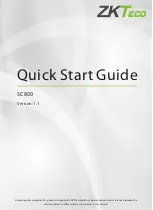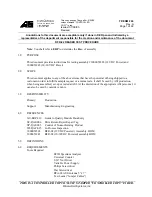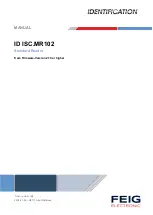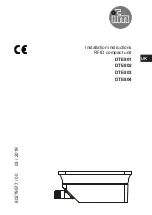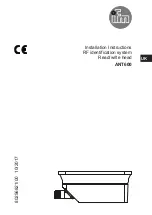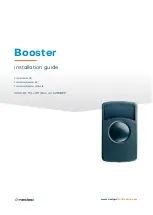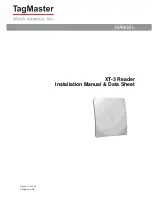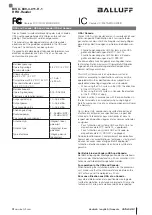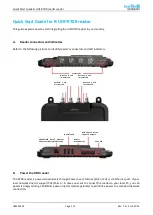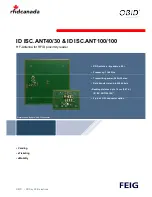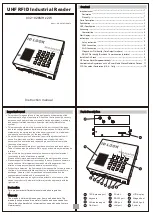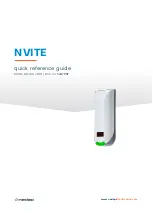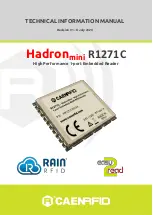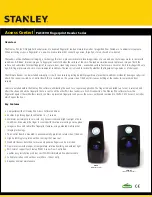
- 2 -
IT
ALIANO
EN
GLISH
Mi 2521/1
3) Abilitazione della funzione scheda Master (MC):
Per poter utilizzare una scheda Master è necessario preliminarmente
abilitare la funzione tramite il passo “3”. La scheda memorizzata
successivamente come descritto al punto “1a” sarà la scheda Master.
Selezionando il terzo passo di programmazione si avrà un beep lungo
ad indicare che la funzione scheda Master è stata abilitata o un beep
breve ad indicare la funzione scheda Master è stata disabilitata.
4) Modalità relè:
Il relè interno può essere programmato sia in modalità monostabile
(impostazione di fabbrica) sia bistabile. Per modificare la modalità di
funzionamento del relè: selezionare il passo di programmazione “4”,
premere il pulsante SW1: un beep breve indicherà la selezione della
modalità monostabile, mentre un beep lungo indicherà la selezione
della modalità bistabile.
5) Durata dell'attivazione del relè:
Per modificare la durata di attivazione del relè: selezionare il passo
5 di programmazione, premere il pulsante SW1, il led si accenderà,
da questo momento è possibile selezionare il tempo di attivazione (1
secondo - 100 min),premere il pulsante SW1 al termine dell’intervallo
temporale richiesto.
6) Cancellazione di tutte le carte:
Per cancellare completamente tutte le carte precedentemente
memorizzate: selezionare il passo 6 e premere il pulsante SW1, il led
rosso rimarrà acceso per alcuni secondi e quindi verrà emesso un beep
lungo per conferma.
Si raccomanda di prestare attenzione alla selezione del passo
di programmazione “6” in quanto non è possibile annullare
l'operazione. La selezione del passo di programmazione “6”
cancellerà anche l’eventuale scheda Master memorizzata (ma
non disabiliterà la funzione scheda Master).
IT
Schema di collegamento con alimentatore ester
-
no in comune con la serratura
EN Wiring diagram with external power supply in
combination with the door lock release.
IT
Sequenza di montaggio
Per il montaggio del modulo lettore di prossimi-
tà sul retro della TD2000R o TD2000RA, seguire
l’ordine mostrato nella figura accanto:
1. Posizionare l’antenna RFID al centro della fi
-
nestra prestando attenzione che la gomma di
protezione sia rivolta verso l’alto e che i due
terminali escano verso la parte centrale della
pulsantiera;
2. Inserire la piastrina di acciaio fornita in do-
tazione alla TD2000R o TD2000RA facendola
scorrere attraverso le due barre filettate;
3. Avvitare i due dadi distanziali, evitando di
serrarli troppo per non danneggiare l’antenna
RFID;
4. inserire il circuito e quindi bloccarlo utilizzan-
do due ulteriori dadi di fissaggio.
La ACI Srl Farfisa Intercoms si riserva il diritto di modificare in qualsiasi momento i prodotti qui illustrati.
ACI Srl Farfisa Intercoms reserves the right to modify the products illustrated at any time.
ACI srl Farfisa Intercoms
Via E. Vanoni, 3 • 60027 Osimo (AN) • Italy
Tel: +39 071 7202038 (r.a.) • Fax: +39 071 7202037
e-mail: [email protected] • www.farfisa.com
Directive 2012/19/EU (WEEE-RAEE)
Smaltire il dispositivo secondo quanto prescritto dalle norme per la tutela dell'ambiente.
Dispose of the device in accordance with environmental regulations.
Mi2521/1
6
1
2
4
3
5
FP2000
PB
TD2000R
TD2000RA
PB
S+
S-
6
1
2
4
3
5
FP2000
IT
Schema di collegamento con serratura alimentata dalla pulsan
-
tiera TD2000R / TD2000RA stessa
EN Wiring diagram with door lock supplied by the door station
TD2000R / TD2000RA itself
EN Mounting sequence
To mount the RFID reader module on the
TD2000R or TD2000RA back it is recommended
to follow the order showed on the picture here:
1. Place the RFID antenna on the window center
being careful that the side with rubber is on the
top and that the 2 terminals come out toward
the door station’s center;
2. Insert the inox plate provided with TD2000R
or TD2000RA by sliding it through the two thre
-
aded rods;
3. Screw the two spacer bolts, avoiding to ti-
ghten too much to do not damage the RFID an-
tenna;
4. Insert the PCB circuit and then fix it in the po
-
sition using the last two bolts.
according to the point “1a” will be the Master Card. Selecting the
programming step 3 the reader will emit a long beep for Master Card
function enabled or a short beep for Master Card function disabled.
4) Relay mode:
The built-in relay can be programmed to work in monostable mode (by
default) or in bistable mode.
To change the relay mode: enter the programming step “4”, press SW1:
a short beep means monostable mode is selected, a long beep the
bistable mode is selected.
5) Duration of relay activation:
To change the duration of relay activation: enter the fifth step, press
SW1, the led turns on, from that moment you can set the time of acti
-
vation (1 second - 100 min), press again SW1 till the end of the required
period.
6) Ereasing all the cards:
To completely erase the card information: enter the sixth step and
press SW1, the red led will be on for few seconds and then a long beep
will be emitted to confirm.
It is recommended to be careful to select the programming step
“6” since it is not possible to undo the operation. By selecting
the programming step “6” event the Master card will be deleted
(but the Master card function will be not disabled)
It is reccommended to carefully handle the
RFID antena terminals to avoid damages
during its mounting. Do not power the device
before connecting the RFID antenna.
Si raccomanda di prestare attenzione nel
maneggiare i terminali dell’antenna RFID per
non danneggiarla irreparabilmente durante
il montaggio. Non alimentare il dispositivo
senza prima aver collegato l’antenna.



